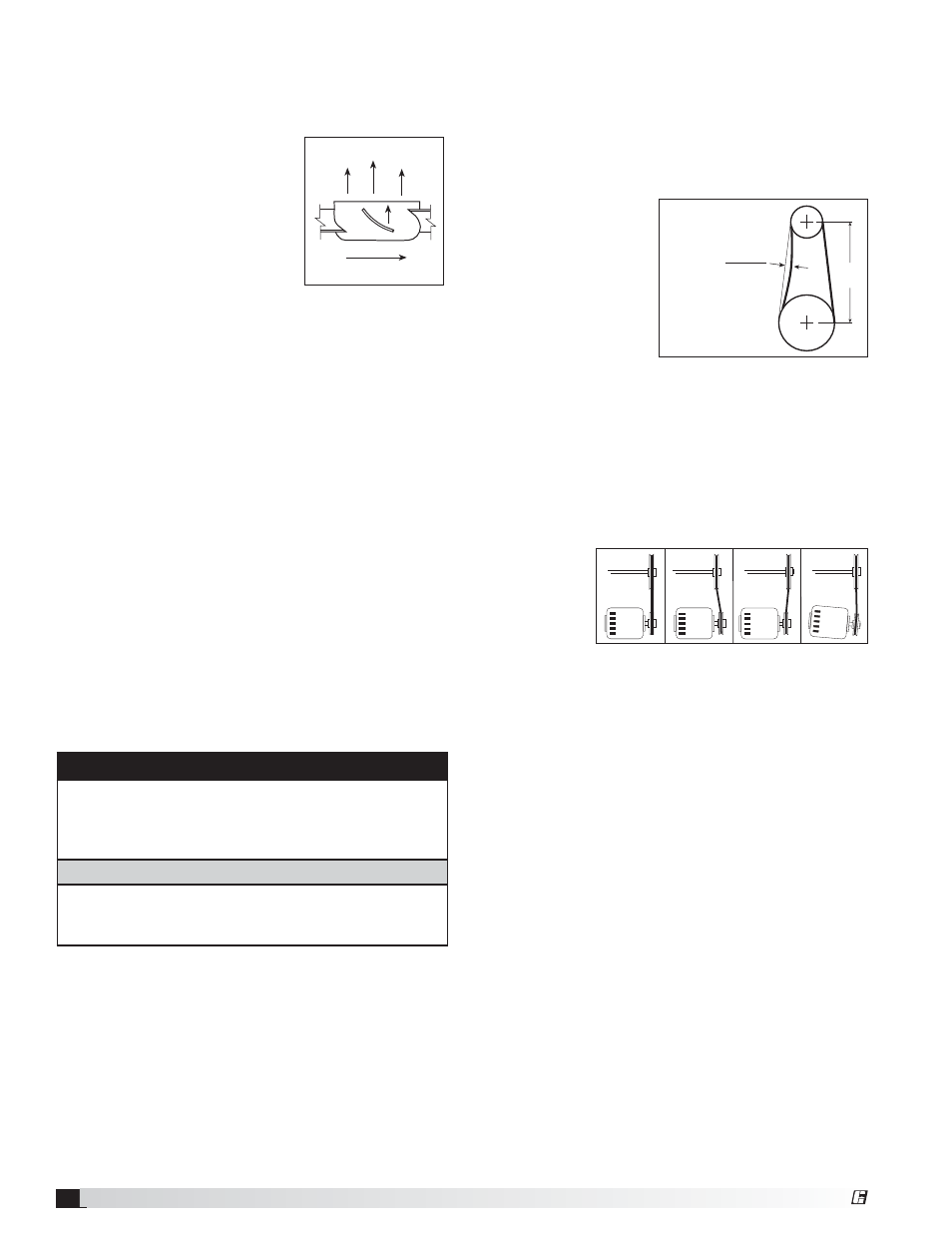Routine maintenance, Pre-starting checks, For belt drive fans – Greenheck RDU/RBU/RBUMO (455700) User Manual
Page 4: Belts, Bearings (for belt drive fans only), Fasteners and set screws, Danger

Propeller Upblast Roof Fans
4
4
Propeller Upblast Roof Fans
Routine Maintenance
Once the fan has been put into operation, a periodic
maintenance program should be set up to preserve
the reliability and performance of the fan. Items to be
included in this program are:
• Belts
• Bearings
• Fasteners
• Set Screws
• Lubrication
• Removal of Dust and Dirt
• Damper Inspection and Service
DANGER
Disconnect and secure to the “OFF” position all
electrical power to the fan prior to inspection or
servicing. Failure to comply with this safety precaution
could result in serious injury or death.
DANGER
Pour écarter les risques de blessure grave ou de mort,
débrancher et verrouiller l’alimentation électrique en
position « Arrêt » avant tout contrôle ou entretien.
Pre-Starting Checks
Check all fasteners and set screws for tightness. This is
especially important for bearing set screws.
The propeller should rotate
freely and not rub on the fan
panel venturi. Rotation direction
of the propeller should be
checked by momentarily turning
the unit on. Rotation should
be in the same direction as the
rotation decal affixed to the unit
or as shown in Fig. 4.
For 3-phase installations, fan rotation can be reversed
by simply interchanging any two of the three electrical
leads. For single phase installations, follow the wiring
diagram located on the motor.
For Belt Drive Fans
The adjustable motor pulley is preset at the factory for
the specified fan RPM. Fan speed can be increased
by closing or decreased by opening the adjustable
pulley. Two or three groove variable pitch pulleys
must be adjusted an equal number of turns open. Any
increase in fan speed represents a substantial increase
in horsepower required from the motor. Always check
motor load amperage and compare to name plate
rating when changing fan speed.
Rotation
Fig. 4
Belts
Premature belt failures are frequently caused by
improper belt tension (either too tight or too loose) or
misaligned pulleys. The proper tension for operating a
V-belt is the lowest tension at which the belts will not
slip at peak load conditions. For initial tensioning, the
proper belt deflection half way between pulley centers
is 1/64 inch for each
inch of belt span. For
example, if the belt span
is 64 inches, the belt
deflection should be one
inch using moderate
thumb pressure at
midpoint of the drive
(Fig. 5).
Check belt tension two times during the first 24 hours
of operation and periodically thereafter. To adjust belt
tension, simply loosen four fasteners (two on each side
of the motor plate) and slide the motor plate away from
the fan shaft until proper belt tension is attained. On
some fans, fasteners attaching the motor to the motor
plate must be loosened in order to adjust the belt.
It is very important that the drive pulleys remain
in proper alignment after adjustments are made.
Misalignment
of pulleys
will result in
premature belt
wear, noise,
vibration and
power loss. (Fig. 6)
Bearings (for belt drive fans only)
Bearings are the most critical moving part of the fan
and should be inspected at periodic intervals. Locking
collars, set screws and fasteners attaching the bearings
to the bearing plate, must be checked for tightness. In a
clean environment and temperatures above 32ºF/below
200ºF, fan shaft bearings with grease fittings should be
lubricated semi-annually using a high quality lithium
based grease. If unusual environmental conditions exist,
temperatures below 32ºF/above 200ºF, moisture or
contaminants, more frequent lubrication is required.
With the unit running, add grease very slowly with a
manual grease gun until a slight bead of grease forms
at the seal. Be careful not to unseat the seal by over
lubricating or using excessive pressure. Bearings
without grease fittings are lubricated for life.
Fasteners and Set Screws
Any fan vibration has a tendency to loosen mechanical
fasteners. A periodic inspection should include checking
all fasteners and set screws for tightness. Particular
attention should be paid to set screws attaching the
propeller to the shaft and the shaft to the bearings.
Loose bearing set screws will lead to premature failure
of the fan shaft.
Deflection =
Belt Span
64
Belt
Span
Fig. 5
WRONG
CORRECT
WRONG
WRONG
Fig. 6
®
